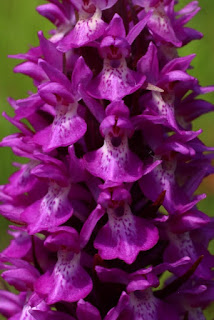Cranham Common in Gloucestershire, a 40 minute drive from Hooky, has amongst other orchids such as Early Purple and common Spotted, records for both the UK species of butterfly orchids (Lesser: Platanthera bifolia, Greater: P. chlorantha).
 |
| Cranham Common |
 |
| Drinker Moth Caterpillar |
 |
| Early Purple Orchid |
We went there today to gather some data about the populations to compare and contrast with the dataset that we generated on Skye. How does the morphology of plants compare growing 500 mile apart and in warmer drier conditions. Our Skye results were summarised in a couple of notes we did for BSBI News and in preparation, awaiting a little more work on the statistical analysis, we have a paper on plant longevity and climate influences.
At Cranham we found no Greater butterfly orchids in flower, but in one spot perhaps 30 lesser butterfly orchids of which 10 were in flower. Our Skye dataset says that lesser flowers earlier than greater, and maybe this was borne out at Cranham Common. We measured height, leaf width, and the number of flowers for all 10, and the labellum width, length, spur length and width of flower for a few.
 |
| Lesser Butterfly Orchid |
 |
| Lesser Butterfly Orchid |
It is a little dangerous to draw with so few data points for Cranham but nevertheless the differences were not as large as I had expected, leaves quite a bit larger, 60%, and 39% more flowers, but the average height was only 18% greater at Cranham.
|
N |
Lf width cm |
Ht cm |
Flowers |
| Skye |
>400 |
2.43 |
17.52 |
11.77 |
| Cranham |
10 |
3.82 |
20.75 |
16.33 |
The environment was quite different. On Skye they seem to avoid competition but at Cranham in the open on a limestone bank, they were growing amongst grasses, roughly as high as the orchids.
 |
| Lesser Butterfly Orchid |
I am hoping to get more data points from other localities in surrounding counties in the next few weeks (there are very few recent records for either species in Oxfordshire).
But the oddest thing was that of the 10, 5 were probably the hybrid P. x hybrida. Whilst most characteristics such as the data above spoke to an identification as P. bifolia, the spur lengths were variable and the pollinia positioning was not parallel, and the subtended angle of the pollinia was greater than zero, but not as wide as P.chlorantha. I have asked BSBI's orchid referee for his thoughts. I think that the hybrid is more generally under recorded.
 |
| Putative Hybrid |
 |
| Putative Hybrid |
 |
| Putative Hybrid |





























